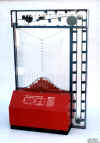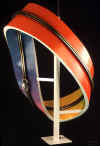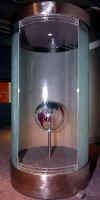MATH AND GEOMETRY
|
| PYTHAGOREAN THEOREM |
 |
| These three units demonstrate and act as a
visual proof of the Pythagorean Theorem. Click on the top thumbnail to
see all three in stereo, then click on each below to see it enlarged.
The clear model on left shows the classical example with squares. The
Pythagorean Theorem states that the sum of the squares of the two short
sides of a right-angle triangle equal to the square of the hypotenuse.
This is true not only for squares, but also for any similar shapes
constructed on each of the three sides of the triangle: semi-circles in
the middle and hexagons in the right-hand photo. |
 |
 |
 |
| The models contain color liquid which flows
between the shapes. The two small shapes are always the same area (or
volume as in the cases above) as the large shape. |
|
 |
PROBABILITY CURVE MACHINE - This large
10-foot machine drops hundreds of small red balls through a grid of
pins. As the balls trickle down through the pins, they arrange
themselves in a typical shape as a natural result of the statistical
probability of the balls' distribution. While we can't say with
certainty where a single ball will end up, we can predict with great
accuracy the probability of many balls to behave in a certain way and
to distribute themselves following the famous bell-curve shape. |
|
|
|
| MÖBIUS STRIP - This shape has only
one side. When the little car travels around it, and completes what
would otherwise be one complete revolution, it finds itself on the
"back" of where it came from. As it continues to travel, it
arrives at the spot where it started but travels twice the distance
compared to traveling either on the inside or outside of a cylinder.
Make a Möbius strip from a strip of paper twisted once before its ends
are attached. Then cut along the center of the strip and - surprise! You
get not two, but one longer Möbius strip. Now instead of cutting along
the center line, cut about a third down the way. You are in for an even
bigger surprise! |
 |
|
|
|
 |
HYPERBOLIC PARABOLOID - This shape is formed from straight lines. The solid brass rods which hang vertically
initially, are given a partial turn to form this curved 3-dimensional
shape. |
 |
CYLINDER - The above shape is derived
initially from the cylinder to the left. A partial turn of the base with
a knob, creates the hyperbolic paraboloid. |
 |
PLANE TO HELIX - In this, slightly
different version of the above, giving a quarter turn to the base,
converts a "flat plane" made up of straight lines, into a
segment of a helix. |
|
|
| ANAMORPHIC IMAGES - We have all seen
anamorphic images although we don't associate them as such. Any
distorted image is in effect anamorphic but some have been distorted in
a special way. On the picture at right, a cylindrical mirror
reflects a distorted image around it. When one looks at the reflected
image in the cylinder, the unrecognizable drawing takes the shape of a
recognizable face. An everyday example is the elongated road signs at
intersections. When viewed from a very shallow angle, as when sitting at
a car wheel, one can read the message without noticing the distortion.
Many famous painters have used this technique a few hundred years ago. |
 |
 |
See a stereo photo of the anamorphic display
above. |
|
|
|
| MAP PROJECTIONS - In the center of the
clear globe is a bright spot light which illuminates the globe evenly
from the center and casts a shadow of the painted countries on the
frosted surface around the globe. This is part of a series of exhibits
on Geography for the Hong Kong Science Centre. Created at Levy Design in
Portland, Oregon USA. |
 |
|
|
|
| All exhibits above where created in several
replicas for different museums around the world by Levy Design, in
Portland, Oregon USA. |